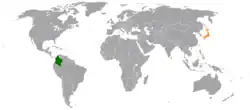 | |
Colombia |
Japan |
|---|---|
Colombia–Japan relations (Spanish: Relaciones entre Colombia y Japón, Japanese: 日本とコロンビアの関係) are the diplomatic relations between Colombia and Japan. The relationship was officially established in 1908, only interrupted between 1942 and 1954 with the surge of World War II. Relations are mostly based on commercial trade that has favored Japanese interests, cultural exchanges, and technological and philanthropic aid to Colombia.[1]
History

Diplomatic relations between Colombia and Japan were established in a treaty called Friendship, Commerce and Navigation signed in Washington, D.C., United States on May 25, 1908. However, the first official embassy was set up by Japan in Bogotá, Colombia in 1934 and the following year Colombia established its embassy in Tokyo.
Commerce
According to the Colombian embassy in Japan, commercial ties between the two countries are increasingly dynamic. In 1996 Japan became the third focus of Colombian imports after the United States and Venezuela with some US$722.5 million (5.6% of total Colombian imports). Japan on the other hand imported some US$348.6 million (less than %1 of Japanese imports).[2]
Japanese products exported to Colombia are mostly assembled vehicles, auto parts, video cameras and communication devices, while Colombian products exported to Japan were mostly coffee, grains, and nickel, and on a minor scale emeralds, exotic reptile skins, and chocolate. Most recently flowers and leather products have also been exported.[2] The relative low commercial exchange is due to Japan's geo-strategic interests in other Latin American countries such as Brazil (where it has an important number of established immigrants), Mexico, Chile, Peru and Argentina. For Colombian producers on the other hand exporting results highly expensive to send more products to Japan when other nearby countries represent more cost-efficient markets and have less economic restrictions.[2]
See also
References
- ↑ (in Spanish) Colombian embassy in Japan Archived 2007-09-03 at the Wayback Machine
- 1 2 3 (in Spanish) Colombian embassy in Japan - statistics Archived 2007-08-11 at the Wayback Machine
External links
- Embassy of Japan in Colombia (in Spanish and Japanese)
- Embassy of Japan in Colombia on Facebook (in Spanish)
- Embassy of Colombia in Japan (in Spanish)

